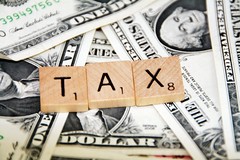
MONROE STREET PARKING LOT IN CHICAGO HOLDS 2,700 CARS FOR COMMUTERS AT LAKE SHORE DRIVE. NEW CONSTRUCTION IS UNDERWAY… – NARA – 556196 (Photo credit: Wikipedia)
While most of the conversation on the recently passed fiscal cliff deal has focused on large-ticket items, such as tax rates, tax breaks, and unemployment benefits, the deal did address and enhance a subsidy for commuters, which is a silver lining for the green movement.
Over the past year, the tax code has provided a subsidy for commuters who drive to work. Under this provision, an employer could cover up to $240 per month in parking expenses tax free for drivers. Conversely, commuters who took public transportation were only covered for up to $125 of their monthly expenses. Under the new fiscal cliff deal, the two benefits are set at equal levels, retroactively for 2012 and for 2013.
This provision definitely is a victory for the green movement, which stresses the need to reduce gas consumption and the number of cars on the road. Also, the argument to increase the benefit to those who take public transportation brings to light the realization that subsidized parking is a distortion because there is a cost involved to provide and maintain parking facilities for drivers, thereby causing an adverse impact on land use.
Hopefully by equalizing the benefit for parking and taking public transportation, more people will opt for the latter. Discussions on programs such as these now entertain the possibility that commuters who opt for the parking subsidy would be allowed to take the cash benefit. The goal here is to encourage car or van pooling, which still goes a long way to reduce the number of automobiles on the road on any given day. Also some jurisdictions are considering plans to increase the cash benefits for commuters who bike to work.
Given that transportation is the second largest household expense for America’s workers, along with the fact that most commuters drive to work alone, provisions to increase commuter subsidies for public transportation and to provide cash benefits for carpooling are very important. They provide strong incentives for people to adopt behaviors that protect the environment, reduce our carbon footprint and successfully live green, be green.
Sources for this Article:
http://www.washingtonpost.com/blogs/wonkblog/post/how-congress-shapes-your-commute/2011/10/19/gIQA7GHOxL_blog.html
http://odenton.patch.com/articles/marc-commuters-could-benefit-from-fiscal-cliff-deal

